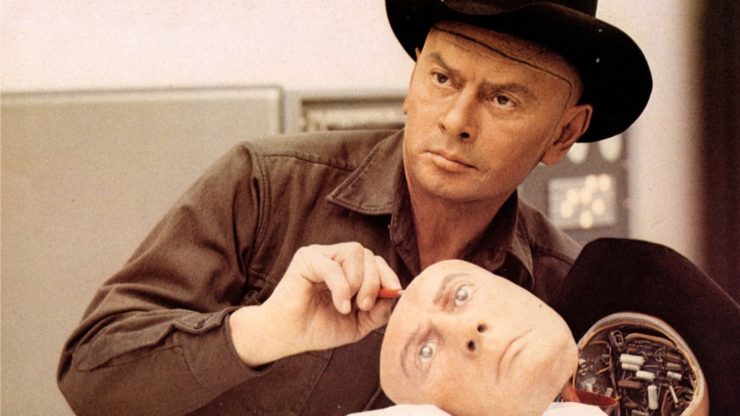Michael Crichton’s 1973 film Westworld is a mediocre Western nestled inside a decent science-fiction thriller. It’s also an impressively clever meta-argument that the Western was always really science fiction to begin with.
The high concept of Westworld is that the film is set in an entertainment theme park, where miraculously realistic robots help immerse visitors in a virtual reality Western World, Medieval World, or Rome World. Each of these generic settings allows visitors to more directly experience typical vicarious film genre pleasures—violence, sex, enforcing the law and violating the law. Robot gunslingers challenge guests to shootouts; robot prostitutes crawl into guests’ beds. These adventures are all completely safe and without consequences, just as film viewers can safely thrill to gun battles or lust after attractive bodies without risking their lives or their marriages. Until, of course, the park starts to break down, and black-hatted robot gunslinger Yul Brynner actually starts to kill people.
Today, the meta-conceit of an invented generic reality is a familiar Hollywood staple, explored in Total Recall (1990), The Truman Show (1998), The Matrix (1999), Cabin in the Woods (2011), Source Code (2011), and the Critchton-inspired Jurassic Park films and Westworld television show, to name just a few examples. The idea was newer to the big screen in 1973, though, and the movie spends a good bit of time on making sure the audience understands exactly where they fit in the entertainment system built for them. The movie opens with an advertisement for Delos, the theme park company that runs Western World, and then segues into another exposition dump, as the two main characters, Peter (Richard Benjamin) and John (James Brolin), talk about what kinds of gun belts they’ll wear on their vacation, and what kind of kick you get from a Colt-45.
The heavy-handed explanation is in part meant to make sure viewers are up to speed. But it’s also a reflection of the movie’s interests.
That interest is not focused on the generic action, which is presented with ersatz half-heartedness. Medieval World looks frankly like a Hollywood set, not like an actual castle. In Western World, Peter and John are pallid protagonists, without much depth or compelling motivation. They jaunt through the Western set-pieces like bland tourists, which is, after all, what they are.
Bored with their tedious over-determined adventures, the movie keeps shifting to the behind-the-scenes mechanics of entertainment production—as if The Lord of the Rings kept cutting away from the action to show segments from the documentaries about the making of The Lord of the Rings. Serious scientists sit before blinking consoles while analog tapes spin in the background. On the quiet Western street, a futuristic clean-up truck drives around picking up humanoid robot bodies, to take them to medical technician types for rewiring and rejiggering. Executives meet in windowless rooms to discuss equipment failure and crisis management. The real action of the movie is not the genre fun, but the bureaucracy.
That’s not just a truth about this film; it’s a general insight about all Hollywood movies. Films are industrial products, assembled by teams of experts, accountants, and technicians. The Western is not a gateway into the frontier past. Rather, it’s a carefully constructed theme park inspired by a past which lacks the technological resources to create that theme park. A Western film, like the Yul Brynner robot itself, is a futuristic machine designed to imitate the Western.
Westerns are generally seen as a grittier, more realistic genre than science fiction. Horses and dust and six-guns are rooted in a historical authenticity that space ships and lasers are not. But Westworld suggests that the weathered storefronts are just pasteboard, and the leathery faces under the cowboy hats are just faux features stretched across an animatronic chassis. Science fiction, with its engineer heroes, and technological accomplishment, is the genre that approximates the actual conditions of film production. When you watch a Western, you’re not really part of the Western genre. You’re part of the science fiction-like world of the movies.
Buy the Book


A Prayer for the Crown-Shy
When the genre setting starts to unravel in the last third of the movie, then, Peter and the film viewer both start to get a look behind the scenes, at the true science fiction that undergirds the faux Western. Brynner ‘s steady disintegration—his face melted by acid, his body set on fire—is a stripping away of the genre façade. He is finally reduced to a hollowed shell, his face torn open, revealing the wires beneath, as his body sparks and flails. It’s like watching the movie screen being torn open, so you see the gears of the projector spinning, or the film crew hammering the set while the effects crew builds a robot Brynner.
The ostensible horror of Westworld is that the safety features break down—the amusement park transforms from a harmless distraction into a nightmarish death-trap. This echoes standard moral panic narratives about the dangers of movies or games or comics. Violence in entertainment, supposedly, sparks violence in real life. When you paint a picture of a gun-battle, you draw real gun-battles into being. Tear away the gunslinger’s mask and you’ll find a boring bureaucrat. But tear away the bureaucrat’s mask, and you’ll once again be looking down the barrel of a gun.
But the anxiety in Westworld may also be that the dangerous gunslingers have been replaced with not-at-all-dangerous images of gunslingers. The future has colonized the past with a bureaucratic simulacra of adventure, sans danger. Westworld acknowledges that the blood and rawhide have been systematically covered with Nerf foam. True grit now is watching some functionary twist dials and speak earnestly into a microphone.
At the conclusion, when Peter looks at the smoking robot and hears the Delos sales pitch playing in his head, is the irony that the supposedly entertaining amusement park is all too capable of harm? Or is the irony instead that the dangerous, high-stakes adventure is all just a safe, boring game? Star Wars and Star Trek try to bring the edgy, frontier excitement of the Western into the future. Westworld, though, suggests that the future has domesticated the past. Science fiction won the west, and turned it into the mechanical reproduction we call a movie.
Originally published October 2020.
Noah Berlatsky is the author of Wonder Woman: Bondage and Feminism in the Marston/Peter Comics (Rutgers University Press).











One of the more prescient bits in the movie is an almost-throwaway comment from the lead designer when he talks about cutbacks making them use androids to build more androids. “It’s machines building machines,” and he’s not too sure about just what they are doing in the factory anymore.
Westworld is science-fiction without the shadow of a doubt but I really don’t see how ordinary Westerns were “always really science fiction to begin with”.
To go a little farther, the Wild West emulated in the Westworld was never really a thing, either. Dime novels and traveling shows of the mid- to late-1800s sold Easterners on this image of rough-and-ready townships, some of whom then moved West in the later decades of the century into towns that were inspired by the mythology.
#4
While the dime novels and traveling shows surely exaggerated a great deal, those rough-and-ready townships were real. As were many of the shootouts. Billy the Kid and Wild Bill Hickok really were killers. Butch Cassidy really did rob those trains. Wyatt Earp really did hunt down his brother’s killers.
Mythology is just the icing on the historical cake.
One of the earlier science fiction Westerns was the 1935 serial The Phantom Empire, which featured the first starring role for Gene Autrey. It’s got radium claim jumpers, robots, ray guns, and the Lost Civilization of Mu residing in a cave system underneath Gene Autrey’s ranch. Also, remember that episode of Futurama where they’re on a planet of human-hating robots, so Fry and Leela have to disguise themselves? Totally happened over sixty years earlier in The Phantom Empire. If you don’t have the endurance for plowing through a serial, it got edited into a feature length presentation entitled Radio Ranch.
I remember watching this when I was younger and wondering why the guns had real bullets in them. Seems like a rather obvious safety issue for everyone.
@1 I also seem to remember a scene where the technicians are discussing how the “malfunctions” seem to be spreading among the robots like an infection, and there is some scoffing about the idea of a cybernetic “disease.” This may be the first suggestion of the concept of a “computer virus” in an SF movie.
The Valley of Gwangi is a 1969 Cowboys and Dinosaurs film. The Dinos, courtesy of Ray Harryhausen, live in a Mexican valley. One that somehow contains the allosaurus and the eohippus, living in the same space at the same time.
Even though it was shot in Spain, it does not count as a spaghetti western.